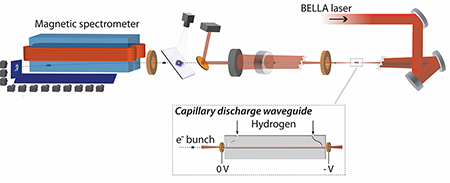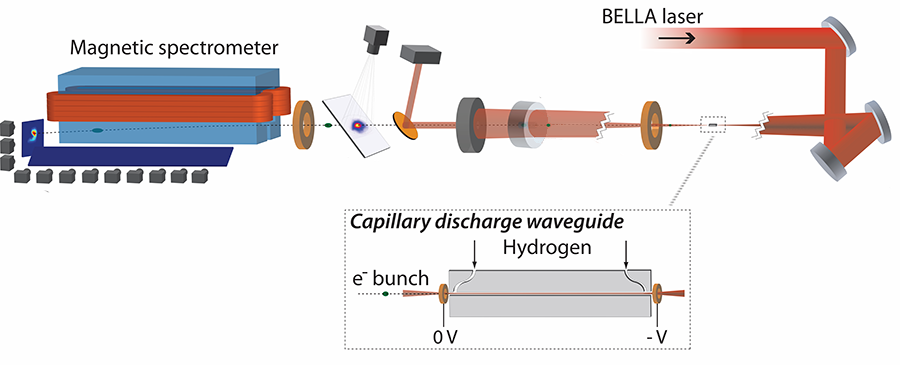Power to the Electrons
Particle accelerators have had a profound impact on science and technology. They contributed to fundamental high-energy-physics experiments like those that revealed the Higgs boson, and are the basis of x-ray sources like synchrotrons and free-electron lasers—invaluable tools for materials sciences and biology. But their further development is hitting practical limits. Conventional schemes accelerate charged particles through the electric fields generated in radiofrequency (rf) cavities. Because of the electrical breakdown of such cavities, the accelerating field cannot exceed ∼100 megavolts per meter (MV/m). This implies that future, higher-energy accelerators would have to be kilometers long and cost billions of dollars.
In the past decade, a possible alternative to conventional accelerator technologies has started to emerge. In a technique known as laser wakefield acceleration (LWFA), the interaction of short, intense laser pulses with a plasma can create accelerating electric fields of several hundred gigavolts per meter (GV/m). Within only few centimeters (cm) length, LWFA can generate beams of electrons with increasing energies, exceeding 1 giga-eletron-volts (GeV). Using a 9-cm-long plasma waveguide, the group of Wim Leemans at Lawrence Berkeley National Laboratory, California, has now demonstrated a scheme that delivers a high-quality electron beam with a record-breaking energy of 4.2GeV [1]—in the same ballpark as the energy of the electrons running in many of today’s large-scale synchrotron facilities.
The LWFA technique, proposed 35 years ago by Dawson and Tajima [2], is based on the use of a short, intense laser pulse to induce density waves in a plasma. As the pulse propagates through the plasma, its electric field separates the plasma’s electrons from the ions. On the pulse trail, the displaced electrons feel an enormous electrostatic force pulling them back toward the heavier, barely moving, ions. This bubble of negative charges trails the laser pulse, moving through the plasma at about the speed of light and producing, in the laser pulse’s wake, a traveling longitudinal electric field that offers a steep acceleration gradient: for typical plasma electron densities ( 1018– 1019cm-3), the resulting accelerating structure is only 10– 100μm long and can sustain fields of over 100 GV/m, outperforming conventional acceleration structures based on superconducting rf cavities by 2–3 orders of magnitude [3]. Once electrons are injected in this plasma wakefield structure they can be accelerated to relativistic energies within very short distances.
The laser intensities needed for LWFA are extremely high, in the so-called relativistic regime (intensities above 1018W/cm2, which accelerate electrons to relativistic speeds). Laser plasma acceleration has thus been driven by technological advances that boosted laser peak and average power, together with stability, repetition rate (pulses emitted per second), and electrical efficiency. Such advances included the advent of diode-pumped solid-state lasers, which are more compact and efficient than flashlamp pumped lasers, and of chirped-pulse amplification (CPA) [4]—a technique in which ultrashort pulses are stretched out in time prior to amplification and compressed to the original duration after amplification. Recent LWFA experiments use CPA lasers with peak-powers in the 10-terawatt-to-petawatt range and pulse durations between tens and hundreds of femtoseconds, firing at a repetition rate of up to a few shots per second.
Several LWPA schemes have been successfully demonstrated that control, to different degrees, the plasma conditions, the electron bunch energy, and its energy spread. By optimizing electron injection mechanisms [5], researchers have been able to generate beams of extremely high quality, featuring a single well-defined energy of up to 2GeV [6], small angular divergence and substantial charge in the electron bunches. Here, the authors realize a significant step forward in energy and efficiency. Using significantly less laser power than in the previous 2-GeV scheme, they accelerate electrons to the highest value obtained to date via lasers: 4.2GeV.
The key to their success was the realization of a much longer interaction length than in previous demonstrations, thanks to a well-prepared guiding structure (see Fig. 1): a 9-cm-long capillary waveguide in which they used a pulsed electrical discharge, appropriately timed before the laser pulse, to preform a plasma channel. The team focused 40-fs laser pulses with 0.3-petawatt peak power into the capillary, to drive the self-injection regime (whereby cold electrons from the plasma are trapped and accelerated in the laser wake). The preformed plasma channel allowed fine control of the plasma density profile inside the waveguide (realizing a parabolic profile with smaller density in the center). Such guiding structure prevents diffractive breakup of the laser pulse, increasing the distance over which the laser intensity stays high. Maximum acceleration was achieved by careful optimization of experimental parameters. One of the key issues was finding optimum plasma conditions for guiding the laser pulse along the full length of the capillary: Guided by numerical modeling, the author chose an ideal plasma density of approximately 7×1017cm-3 [7]. Another essential optimization ingredient was the careful matching of the size of the laser focus to the preformed plasma channel.
The results of Leemans et al. can be regarded as a substantial advancement towards two grand goals of laser plasma acceleration sources. The first would be the realization of a linear electron-positron collider based on multiple LWFA stages. According to a recent proposal [8], a 1-tera-electron-volt (TeV) electron accelerator could be assembled with one hundred 10-GeV acceleration modules and combined with a similar 1-TeV positron accelerator to realize 2-TeV electron-positron collisions. Such a collider would be competitive with the International Linear Collider, a proposed facility based on conventional rf accelerators that, according to current designs, would have to be 30–50 kilometers long. In view of such a large-scale scheme, a major milestone posed by this work is the demonstrated efficiency increase, which substantially reduces the laser power needed to impart a given acceleration. Yet the development of such a collider will certainly take decades of hard work, as it requires substantial technological improvements both on the driving lasers and on the plasma-accelerator structures.
The second goal might be within closer reach. The demonstrated high-energy electron beam could be used to feed an x-ray free-electron laser (XFEL) that would fit into a university laboratory. In a FEL, high-energy electrons zigzag through a periodic arrangement of magnets, called an undulator, organizing themselves into microbunches that emit coherent, laserlike radiation. A laser-driven XFEL would be a very compact alternative (less than 30 m long [9]) to current kilometer-long XFELs like the LCLS or the European XFEL. Should tabletop XFELs become available, a vast number of applications, most notably the determination of the 3D structure of biomolecules [10], could be carried out by a much broader community of researchers, complementing large-scale facilities where beam time is expensive and scarce. Researchers have already demonstrated that laser-accelerated electrons, fed into undulators, can generate (incoherent) short pulse radiation at soft-x-ray wavelengths [11]. If the electrons can be made to emit x rays coherently, the device would turn into a FEL. It is reasonable to think that such a compact laser-driven XFEL could become a reality within the next decade.
Quite a few technological challenges remain. On the laser side, the increase of repetition rate would be useful for both FELs and accelerators to get sufficient photons and/or luminosity. Stability of the lasers will be key to get electron bunches that do not drift in position and energy. Diode-pumped solid-state lasers are key to this development, because they can better manage heating of the laser medium, and feature enhanced stability and electrical efficiency. Arrays of thousands of fiber lasers [12] could be a promising way to scale up the energy and bring the repetition rate well above 10 kilohertz. On the side of the plasma-accelerator stages, a better control of the electron energy spread they induce will be necessary for both FELs and colliders. But many of these obstacles will likely be overcome in coming years, in particular thanks to continuing advances in laser technology, which commercial and scientific applications drive at an extremely rapid pace.
References
- W. P. Leemans et al., “Multi-GeV Electron Beams from Capillary-Discharge-Guided Subpetawatt Laser Pulses in the Self-Trapping Regime,” Phys. Rev. Lett. 113, 245002 (2014)
- T. Tajima and J. M. Dawson, “Laser Electron Accelerator,” Phys. Rev. Lett. 43, 267 (1979)
- V. Malka et al., “Principles and Applications of Compact Laser-Plasma Accelerators,” Nature Phys. 4, 447 (2008)
- D. Strickland and G. Mourou, “Compression of Amplified Chirped Optical Pulses,” Opt. Commun. 56, 219 (1985)
- J. Faure et al., “Controlled Injection and Acceleration of Electrons in Plasma Wakefields by Colliding Laser Pulses,” Nature 444, 737 (2006)
- X. Wang , et al. “Quasi-Monoenergetic Laser-Plasma Acceleration of Electrons to 2 GeV,” Nature Commun. 4, 1988 (2013)
- In the present experiment, the beam’s top-hat spatial profile required higher density than that that would be needed for an ideal Gaussian profile
- W. P. Leemans and E. Esarey, “Laser-Driven Plasma-Wave Electron Accelerators,” Phys. Today 62, No. 3, 44 (2009)
- See the ELI White Book, Science and Technology with High Intensity Lasers, edited by G. Mourou and G. Korn (http://www.eli-beams.eu/wp-content/uploads/2011/08/ELI-Book_neues_Logo-edited-web.pdf)
- M. Bergh, G. Huldt, N. Tîmneanu, F. R. Maia, and J. Hajdu, “Feasibility of Imaging Living Cells at Subnanometer Resolutions by Ultrafast X-Ray Diffraction,” Quart. Rev. Biophys. 41, 181 (2008); R. Neutze, R. Wouts, D. van der Spoel, E. Weckert, and J. Hajdu, “Potential for Biomolecular Imaging with Femtosecond X-ray Pulses,” Nature 406, 752 (2000)
- M. Fuchs et al., “Laser-Driven Soft-X-Ray Undulator Source,” Nature Phys. 5, 826 (2009)
- G. Mourou, B. Brocklesby, T. Tajima, and J. Limpert, “The Future is Fibre Accelerators,” Nature Photon. 7, 258 (2013)





